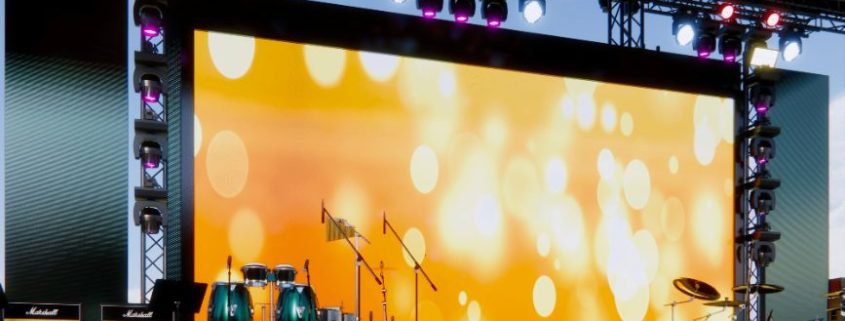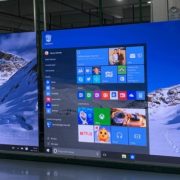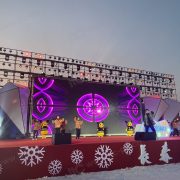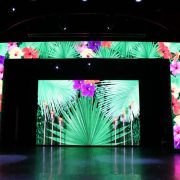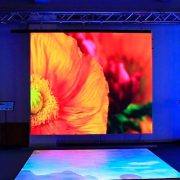Selecting the Perfect Outdoor Stage LED Screen for Your Venue
In the realm of live performances, the integration of visual technology, particularly outdoor stage LED screen, has revolutionized the way audiences experience events. These screens not only amplify the visual appeal but also extend the creative boundaries for artists and event organizers. An outdoor stage LED screen serves as a dynamic canvas, transforming outdoor events into immersive spectacles. From concerts to festivals, the role of LED screens in enhancing viewer engagement and delivering high-definition content is unparalleled, making them an indispensable component of modern outdoor staging.
Advantages of Waterproof Outdoor Stage LED Screen
In the dynamic world of outdoor events, the use of LED screens has become increasingly prevalent, offering a myriad of visual possibilities that were once thought unattainable. Among these advancements, waterproof outdoor stage LED screens stand out as a pivotal innovation, ensuring that performances not only dazzle audiences with vivid imagery but also withstand the unpredictable nature of outdoor environments. The integration of waterproofing technology into outdoor stage LED screens has significantly enhanced their durability and reliability, marking a new era in event staging where the show can truly go on, regardless of weather conditions.
The Imperative of Waterproofing in Outdoor LED Screens
Outdoor events are inherently subject to the whims of nature, with conditions ranging from blistering sunlight to unexpected downpours. In such scenarios, the technological backbone of the event, particularly the LED screens, must be equipped to handle these challenges without faltering. This is where waterproof outdoor stage LED screens come into play, designed specifically to resist water ingress and protect the delicate electronic components housed within.
Waterproofing is not just a feature but a necessity for outdoor LED screens, ensuring that they can operate flawlessly in a variety of weather conditions, from light drizzles to heavy rainfall. The protection afforded by waterproofing extends the lifespan of these screens, safeguarding the investment made by event organizers and providing a reliable platform for visual displays.
Engineering Waterproof Outdoor Stage LED Screens
The process of making an outdoor stage LED screen waterproof involves several technical considerations, from the choice of materials to the design of the screen’s enclosure. Manufacturers employ high-grade, water-resistant materials that can repel water while maintaining the screen’s visual clarity and brightness. The enclosures are meticulously designed to prevent water from entering, using seals and gaskets that withstand the pressures exerted by heavy rains.
Moreover, the electrical components and connections are treated with protective coatings and housed in waterproof compartments, ensuring that the screen’s functionality remains unaffected by moisture. This level of engineering prowess not only enhances the screen’s resilience but also its safety, eliminating the risks associated with electrical malfunctions in wet conditions.
The Role of IP Ratings in Waterproof LED Screens
When discussing waterproof outdoor stage LED screens, the term “IP rating” often comes into the conversation. IP, or Ingress Protection, ratings provide a standardized measure of an enclosure’s effectiveness against the intrusion of solid objects and liquids. For outdoor LED screens, a high IP rating, such as IP65 or IP67, indicates a strong level of protection against dust and water, making these screens well-suited for outdoor use.
These ratings are crucial for event organizers and technical directors when selecting LED screens for outdoor events. They offer a clear indication of the screen’s ability to withstand environmental challenges, providing peace of mind and ensuring that the visual aspects of the event will proceed without interruption.
Uninterrupted Performances with Waterproof LED Screens
The primary advantage of waterproof outdoor stage LED screens lies in their ability to provide uninterrupted performances, regardless of weather conditions. This reliability is paramount in live events, where timing is critical, and delays or cancellations can have significant financial and reputational repercussions.
With waterproof LED screens, event organizers can proceed with confidence, knowing that the visual elements of their event are secure against the elements. This reliability extends to the performers and creative teams as well, who can fully engage with their art without the looming threat of technical difficulties caused by inclement weather.
Beyond Weather: Additional Benefits of Waterproof LED Screens
While the waterproof nature of these screens is a key feature, it also brings additional benefits that enhance their overall performance in outdoor settings. For instance, waterproof screens are generally built to be more robust, making them resistant to other environmental factors such as dust, wind, and UV exposure. This durability translates to a longer service life and reduced maintenance costs, providing a better return on investment for event organizers.
Furthermore, the technology and materials used in waterproof LED screens often result in improved image quality and brightness, ensuring that the visuals remain clear and vibrant, even in direct sunlight. This is crucial for outdoor events, where ambient light can often diminish the impact of visual displays.
The advent of waterproof outdoor stage LED screens has significantly transformed the landscape of outdoor events, offering a blend of durability, reliability, and unmatched visual quality. These screens empower event organizers to push the boundaries of what’s possible, creating immersive and uninterrupted experiences for audiences, come rain or shine.
As technology continues to advance, the capabilities of these screens will only expand, further enhancing the world of outdoor events. The future of outdoor staging looks bright, illuminated by the vibrant and resilient displays of waterproof LED screens, ensuring that the magic of live performances can be fully realized, regardless of the weather.
What are the Outdoor Stage LED Screen Prices
In the dynamic world of event production, the visual component plays a pivotal role in creating memorable experiences. Among the technologies that have revolutionized stage presentations and outdoor events, LED screens stand out for their brightness, clarity, and versatility. Specifically, the outdoor stage LED screen has become a staple for concerts, festivals, and corporate events, offering unparalleled engagement with the audience. However, navigating the pricing landscape of these advanced systems can be complex. This comprehensive guide aims to demystify the factors influencing outdoor stage LED screen prices and provide actionable tips for securing cost-effective solutions without sacrificing quality.
Factors Influencing the Price of LED Screens for Outdoor Stages
Several key factors directly impact the cost of outdoor stage LED screens. Understanding these can help potential buyers make informed decisions tailored to their specific needs and budget constraints.
- Screen Size and Resolution: The dimensions and pixel density of an LED screen are among the primary determinants of its price. Larger screens with higher resolutions offer more detailed and vibrant images but come at a higher cost. The choice of size and resolution should align with the viewing distance and the visual impact desired for the event.
- LED Type and Quality: LED screens are built using different types of LEDs, such as DIP (Dual In-line Package) and SMD (Surface Mounted Device). SMD LEDs, often used in outdoor stage applications for their wide viewing angles and closer viewing distances, typically cost more than DIP LEDs. Additionally, the quality of the LEDs, reflected in their brightness, color uniformity, and lifespan, significantly affects the price.
- Weatherproofing and Durability: Outdoor screens require robust weatherproofing to withstand elements like rain, dust, and extreme temperatures. High-quality weatherproofing measures, including IP (Ingress Protection) ratings, contribute to the cost but are essential for the longevity and performance of the screen in outdoor environments.
- Processing and Control Systems: The hardware and software that control LED screens play a crucial role in image quality and operational flexibility. Advanced processing systems that offer high refresh rates, color processing, and seamless content playback can elevate the cost but are critical for professional-grade presentations.
- Installation and Structural Support: The complexity of the installation and the need for custom structural supports can also influence the overall cost. Permanent installations or those requiring unique mounting solutions due to venue constraints may incur higher expenses.
- Maintenance and Warranty Services: The availability and extent of maintenance services and warranty coverage are also cost factors. A comprehensive warranty and accessible technical support can mitigate future expenses related to repairs and maintenance, providing long-term value.
Tips for Budgeting and Finding Cost-Effective Solutions Without Compromising Quality
Securing an outdoor stage LED screen that meets both budgetary and quality requirements demands strategic planning and research. Here are some tips to achieve the best of both worlds:
- Define Your Requirements Clearly: Start by outlining the specific needs of your event, including screen size, resolution, and expected viewing distances. This clarity will prevent overspending on unnecessary features.
- Compare Quotes and Technologies: Obtain quotes from multiple suppliers and compare the specifications and costs. Be open to exploring different LED technologies that might offer a better price-performance ratio for your specific application.
- Consider Buying Versus Renting: For one-off events or those with varying technology needs, renting an outdoor stage LED screen may be more cost-effective than purchasing. Evaluate the long-term benefits and costs if considering a purchase.
- Look for Package Deals: Some suppliers offer package deals that include installation, maintenance, and even content creation services at a discounted rate. These bundles can provide significant savings.
- Invest in Quality for Longevity: While it’s tempting to opt for the cheapest option, investing in a high-quality LED screen from a reputable manufacturer can result in lower total ownership costs due to fewer repairs and a longer lifespan.
- Negotiate on Ancillary Costs: Don’t overlook the potential to negotiate on aspects beyond the screen itself, such as installation costs, extended warranties, and maintenance packages.
- Plan for Future Flexibility: Choose a system that offers modular components or upgradable features to accommodate future technological advancements or changing event needs without requiring a complete overhaul.
By carefully considering these factors and tips, event organizers and producers can navigate the complexities of outdoor stage LED screen pricing. The goal is to find a solution that not only fits the budget but also enhances the overall event experience with stunning visual displays.
LED Screens for Stage Rental: A Flexible Option
In the ever-evolving landscape of live events, the demand for high-quality visual displays has never been greater. Among the myriad of options available, LED screens have emerged as a cornerstone for enhancing audience engagement and delivering unforgettable experiences. Specifically, the concept of renting outdoor stage LED screens presents a versatile and cost-effective solution for event organizers, catering to a wide range of event sizes and requirements. This approach not only democratizes access to cutting-edge technology but also offers a plethora of benefits that are worth exploring in detail.
The Growing Popularity of LED Screen Rentals for Outdoor Stages
The trend towards renting LED screens for outdoor stages is driven by several factors, chief among them being the flexibility and economic efficiency that rental options provide. Unlike permanent installations, which require a significant upfront investment and long-term commitment, rentals allow event organizers to tailor their visual display solutions to each specific event, ensuring that the technology aligns perfectly with their creative vision and budgetary constraints.
This flexibility is particularly valuable in the context of outdoor events, which can vary greatly in scale, from intimate gatherings to massive festivals. By opting for rental solutions, organizers can select the ideal screen size, resolution, and configuration for each occasion, creating a bespoke visual experience that enhances the event’s overall impact.
Tailoring LED Screen Solutions to Diverse Event Needs
One of the key advantages of renting outdoor stage LED screens is the ability to customize the visual setup to suit different event types and audience sizes. Rental companies typically offer a wide range of LED screen models, each with its own set of features and capabilities. This variety enables organizers to choose screens that best fit the spatial dimensions of the venue, the expected audience size, and the specific content they wish to display.
For smaller, more intimate events, compact LED screens with higher resolutions can provide detailed and vibrant visuals that captivate attendees. Conversely, for large-scale festivals and concerts, massive LED walls can be constructed to ensure that visuals are visible and impactful, even from a distance. This scalability is a crucial aspect of LED screen rentals, allowing for a high degree of customization and ensuring that every event, regardless of size, benefits from optimal visual quality.
Economic Advantages of LED Screen Rentals
Beyond the flexibility and customization benefits, the economic aspect of renting outdoor stage LED screens cannot be overstated. For many event organizers, especially those operating on tight budgets or organizing one-off events, the cost of purchasing and maintaining LED screens can be prohibitively expensive. Rentals, on the other hand, offer a more financially viable option, allowing access to the latest technology without the need for a large capital expenditure.
Moreover, rental agreements often include setup, maintenance, and technical support services, further reducing the logistical and financial burden on organizers. This comprehensive service package ensures that the screens perform optimally throughout the event and that any technical issues are promptly addressed, minimizing downtime and enhancing the overall event experience.
Enhancing Event Versatility with LED Screen Rentals
The versatility of LED screens, particularly when rented, extends beyond their physical adaptability to include content versatility. With advanced content management systems, organizers can easily update and change the displayed content in real-time, allowing for dynamic and interactive visual experiences. This capability is particularly useful for events with multiple acts or segments, as it enables seamless transitions between different visual themes and messages.
Furthermore, the interactive features of modern LED screens, such as touch capabilities and integration with social media feeds, open up new possibilities for audience engagement. These interactive elements can transform passive viewers into active participants, creating a more immersive and memorable event experience.
Navigating the Rental Process: Considerations and Best Practices
While the benefits of renting outdoor stage LED screens are clear, navigating the rental process requires careful consideration to ensure that the chosen solution perfectly aligns with the event’s needs. Key factors to consider include the screen’s brightness and visibility in outdoor conditions, the ease of installation and dismantling, and the reliability of the rental company’s technical support.
It’s also advisable to work closely with the rental provider to understand the technical specifications of the available screens and to plan the layout and integration of the screens into the event’s overall design. This collaborative approach ensures that the screens enhance, rather than detract from, the event’s aesthetic and thematic goals.
The option to rent outdoor stage LED screens offers a strategic advantage for event organizers, combining the flexibility and customization needed to create tailored visual experiences with the economic efficiency that makes high-quality displays accessible to a wider range of events. As the technology behind LED screens continues to advance, the possibilities for creative and engaging outdoor events will only expand, further cementing the role of LED screen rentals as a key component in the event industry’s toolkit. By leveraging these dynamic and versatile displays, organizers can elevate their events, ensuring that each one leaves a lasting impression on attendees.
Choosing the Best Outdoor Stage LED Screen
In the vibrant world of outdoor events, the visual component plays a pivotal role in creating an immersive experience for the audience. The heart of this visual spectacle often lies in the dynamic and captivating displays provided by outdoor stage LED screens. These screens not only bring performances to life but also serve as a canvas for creative expression. Selecting the best outdoor stage LED screen is a critical decision for event organizers, one that can significantly impact the success of an event. This comprehensive guide delves into the key features to consider when choosing an outdoor stage LED screen and highlights some of the top products and innovations in the market, drawing inspiration from industry leaders like ROE Visual.
Key Features to Consider
When it comes to selecting an outdoor stage LED screen, there are several crucial features to consider, each playing a vital role in ensuring the screen meets the demands of outdoor events.
- Brightness and Clarity: Outdoor environments demand high-brightness screens to combat direct sunlight and maintain clear visibility. Look for screens with a brightness exceeding 5,000 nits to ensure your content remains vibrant and visible, even in broad daylight.
- Weather Resistance: Given their exposure to the elements, outdoor stage LED screens must boast robust weather resistance. This includes not only waterproofing but also resistance to dust, wind, and UV rays. An IP rating of IP65 or higher is indicative of a screen well-suited for outdoor conditions.
- Resolution and Pixel Pitch: The resolution, determined by the pixel pitch, is crucial for image quality. The choice of pixel pitch should align with the typical viewing distance; closer distances require smaller pixel pitches for a clearer image.
- Durability and Build Quality: The structural integrity of the screen is paramount, especially in outdoor settings where it may face harsh weather conditions. High-quality materials and construction not only extend the lifespan of the screen but also ensure safety for both the audience and performers.
- Ease of Assembly and Disassembly: For touring events and festivals, the ease with which a screen can be assembled, disassembled, and transported is key. Modular designs and user-friendly locking systems can significantly reduce setup times and logistical challenges.
- Energy Efficiency: Outdoor events often run for extended periods, making energy efficiency a critical factor. LED screens that balance high performance with low power consumption can lead to significant cost savings over time.
- Service and Support: Access to reliable service and technical support is essential, particularly for large-scale events where screen downtime can have major repercussions. Opt for manufacturers and suppliers known for their after-sales support and technical assistance.
Highlighting Top Products and Innovations
Drawing inspiration from ROE Visual, a leader in the LED screen industry, let’s explore some of the top products and innovations that set the standard for outdoor stage LED screens.
- ROE Visual Black Pearl: The Black Pearl series is renowned for its exceptional image quality and robust design, making it an excellent choice for outdoor stages. Its high refresh rate and wide color gamut ensure stunning visuals that captivate audiences.
- ROE Visual Diamond DM2.6: Designed for both rental and fixed installations, the Diamond DM2.6 offers a perfect blend of high performance and cost-effectiveness. Its lightweight design and easy assembly make it ideal for touring events and festivals.
- ROE Visual Carbon Series: Incorporating carbon fiber technology, the Carbon series stands out for its lightweight yet durable construction. This series is particularly suited for large-scale outdoor events where ease of handling and structural integrity are paramount.
- Innovative Transparency Solutions: ROE Visual’s Vanish series, with its high transparency, offers creative possibilities for outdoor stages, allowing for immersive visual experiences that blend seamlessly with the environment.
- Advanced Weatherproofing Technologies: ROE Visual’s commitment to outdoor readiness is evident in their advanced weatherproofing technologies, ensuring their screens can withstand the rigors of outdoor use while maintaining top-notch visual performance.
Choosing the best outdoor stage LED screen is a multifaceted decision that requires careful consideration of various factors, from technical specifications to logistical requirements. By focusing on key features such as brightness, weather resistance, resolution, and durability, and drawing inspiration from industry-leading products and innovations, event organizers can select a screen that truly enhances the outdoor event experience. As technology continues to evolve, the potential for creative and engaging outdoor displays is boundless, with outdoor stage LED screens at the forefront of this exciting frontier.
LED Screens for Concert Stages: Enhancing Live Music Experiences with Outdoor Stage LED Screen Technology
In the realm of live music, the advent of outdoor stage LED screen technology has revolutionized the way performances are presented and experienced. These screens not only amplify the visual aspect of concerts but also enhance the overall engagement between artists and their audiences. The impact of outdoor stage LED screens on live concert performances is profound, offering a myriad of benefits ranging from heightened visual appeal to improved audience interaction. Through various examples of successful LED screen integrations in concerts, we can appreciate the transformative power of this technology in the live music industry.
The Impact of Outdoor Stage LED Screens on Live Concert Performances
Outdoor stage LED screens serve as a dynamic backdrop for artists, enabling the visualization of stunning graphics, live feeds, and intricate light shows that complement the musical performance. This visual augmentation adds a layer of immersion and excitement that traditional stage setups cannot achieve. For outdoor concerts, particularly, where natural light can diminish the visibility of stage elements, LED screens ensure that visuals remain vibrant and engaging throughout the event.
- Visual Immersion: Outdoor stage LED screens can transform a concert into a fully immersive experience. Through high-definition visuals and animations, these screens can transport audiences to different worlds, amplify the emotional impact of songs, and enhance storytelling.
- Audience Engagement: The use of live camera feeds on LED screens makes it possible for attendees, even those at the back of large venues, to see close-up views of the performers and onstage action. This inclusivity bridges the gap between artists and audience members, making the concert experience more intimate and memorable.
- Artistic Expression: For artists, outdoor stage LED screens offer a new canvas for creative expression. They can design custom visuals that reflect the themes of their music or tour, adding a unique visual identity to their performances.
- Brand Integration: Beyond artistic purposes, these screens provide opportunities for strategic branding and sponsor activations. This can be especially beneficial for festivals and tours, where sponsor visibility is crucial.
Examples of Successful LED Screen Integrations in Concerts
Several iconic concerts and tours have demonstrated the incredible potential of outdoor stage LED screens in enhancing live music experiences:
- U2’s 360° Tour: U2’s 360° Tour featured a massive LED screen that not only displayed live feeds and visuals but was also fully cylindrical, allowing audiences from all angles to experience the visuals. This groundbreaking use of LED technology set new standards for live concert productions.
- Beyoncé’s Coachella Performance: Beyoncé’s historic Coachella performance utilized outdoor stage LED screens to great effect, projecting powerful visuals that complemented her music and choreography. The screens played a crucial role in storytelling, showcasing cultural symbols and historical references that enriched the performance.
- Coldplay’s A Head Full of Dreams Tour: Coldplay’s tour was notable for its use of wristbands that lit up in sync with the visuals displayed on the outdoor stage LED screens, creating a unified, immersive experience that connected the audience with the performance on a visceral level.
- EDM Festivals: Electronic Dance Music festivals like Tomorrowland and Ultra Music Festival have leveraged outdoor stage LED screens to elevate the sensory experience, with synchronized light shows and visuals that match the beats and drops of the music, creating an electrifying atmosphere.
These examples illustrate not just the versatility of outdoor stage LED screens in concert settings but also their ability to transform the live music experience into something truly extraordinary. As technology continues to evolve, we can expect even more innovative uses of LED screens in the music industry, further blurring the lines between concert and spectacle.
Outdoor stage LED screens have become a game-changer in the live music scene, offering enhanced visual experiences that complement the auditory enjoyment of concerts. From creating immersive environments to facilitating deeper connections between performers and audiences, the integration of LED technology has undoubtedly raised the bar for live performances. As artists and producers continue to explore the creative potentials of LED screens, concert-goers can look forward to even more visually stunning and memorable experiences.
LED Stage Screens for Sale: Making a Long-Term Investment
In the realm of live events, the allure of an outdoor stage LED screen is undeniable. These screens not only elevate the audience’s experience with crisp, vivid imagery but also serve as a dynamic backdrop that can transform any outdoor stage into a mesmerizing spectacle. However, the decision to purchase an LED screen for a permanent or semi-permanent outdoor stage setup is a significant investment. It requires careful consideration of several factors to ensure that the investment is sound and sustainable over the long term. This guide delves into the critical aspects of purchasing outdoor stage LED screens, focusing on maintenance, longevity, and the overall value of owning such advanced visual technology.
Considerations for Purchasing LED Screens for Permanent or Semi-Permanent Outdoor Stage Setups
When contemplating the acquisition of an outdoor stage LED screen, the decision-making process should be thorough and detail-oriented. Here are key considerations to guide your purchase:
- Purpose and Usage: Define the primary function of the LED screen in your outdoor stage setup. Consider the types of events it will be used for, the expected audience size, and the content you plan to display. These factors will influence the screen’s size, resolution, and technical specifications.
- Environmental Conditions: Outdoor screens are exposed to various weather conditions, including rain, sunlight, and extreme temperatures. Opt for screens with high IP ratings that signify strong resistance to dust and water. Additionally, consider the screen’s sunlight readability, ensuring it can perform well even in direct sunlight.
- Technical Specifications: Dive into the specifics, such as pixel pitch (resolution), brightness (measured in nits), refresh rate, and contrast ratio. These technical parameters determine the screen’s visual quality and performance. A lower pixel pitch and higher brightness are preferable for outdoor stages to ensure clear visibility even from a distance and in bright conditions.
- Installation and Integration: Assess the complexity of installing the LED screen and integrating it with existing sound and lighting systems. Permanent installations may require structural modifications and should comply with local building codes and safety standards.
- Budget and Cost of Ownership: Beyond the initial purchase price, consider the total cost of ownership, which includes installation, maintenance, and potential repair costs. A more expensive, high-quality screen might offer lower long-term costs due to its durability and efficiency.
Maintenance and Longevity of Owned LED Screens
Owning an outdoor stage LED screen comes with the responsibility of maintaining it to ensure its longevity and optimal performance. Proper maintenance not only extends the life of the screen but also protects your investment. Here are strategies to maintain and maximize the lifespan of your LED screen:
- Regular Cleaning: Dust, dirt, and other particulates can accumulate on the screen’s surface and within its components, potentially affecting image quality and cooling efficiency. Regular cleaning, following the manufacturer’s guidelines, is essential to maintain clarity and prevent overheating.
- Environmental Protection: While outdoor screens are designed to withstand the elements, taking additional protective measures can extend their lifespan. For example, installing protective covers when the screen is not in use can safeguard against harsh weather conditions and physical damage.
- Routine Inspections: Schedule routine inspections to identify and address potential issues before they escalate. This includes checking for damaged LEDs, ensuring all connections are secure, and verifying that cooling systems are functioning correctly.
- Software Updates and Calibration: Keep the screen’s software up to date and perform regular calibration to ensure optimal performance and image quality. Calibration adjusts the screen’s color and brightness levels, maintaining a consistent and vibrant display.
- Professional Maintenance Services: Consider contracting professional maintenance services from the screen manufacturer or a certified third party. These experts can perform detailed inspections, thorough cleanings, and necessary repairs, ensuring the screen operates at its best.
- Warranty and Support: Finally, take advantage of the warranty and support services offered by the manufacturer. A comprehensive warranty can cover repairs and replacements, reducing out-of-pocket costs for maintenance issues.
Making a long-term investment in an outdoor stage LED screen is a decision that can significantly enhance the quality of outdoor events. By carefully considering the purchase and committing to ongoing maintenance, event organizers and venue owners can ensure that their LED screen remains a vibrant centerpiece of their outdoor stage setup for years to come. This approach not only maximizes the return on investment but also consistently delivers the high-impact visual experiences that audiences have come to expect from outdoor events.
The Impact of Big LED Screens on Outdoor Stage Presentations
The advent of big LED screens has dramatically transformed the landscape of outdoor stage presentations, ushering in an era where the boundaries between reality and digital spectacle blur. These colossal canvases not only magnify the visual impact of performances but also redefine audience engagement, setting a new standard for live events. The integration of an outdoor stage LED screen, particularly of a significant size, brings a multitude of benefits, from enhanced visibility to immersive visual storytelling. However, the deployment of such technology comes with its own set of technical considerations, each critical to the successful integration of big LED screens into outdoor events.
Transforming Visual Experience for Audiences
The primary allure of big LED screens in outdoor stage settings lies in their unparalleled ability to amplify the visual experience for audiences. These screens make it possible to bring cinematic quality visuals to the live stage, allowing for a level of detail and vibrancy that was previously unattainable. High-definition imagery, dynamic backgrounds, and intricate visual effects can be displayed with stunning clarity, making every seat the best seat in the house.
Moreover, big LED screens facilitate a level of creative expression that can elevate performances to new heights. They serve as a dynamic backdrop that can change with the mood of the show, extend the physical stage with virtual environments, or even interact with the performance in real-time. This versatility transforms the outdoor stage into a canvas for artists and designers, where the only limit is their imagination.
Enhancing Audience Engagement
Beyond the sheer visual spectacle, big LED screens play a pivotal role in enhancing audience engagement. In large outdoor venues, where the distance between the stage and the audience can diminish the impact of the performance, big LED screens ensure that every gesture, expression, and detail is visible to all attendees, creating a more intimate and connected experience.
Interactive elements can also be incorporated, such as live social media feeds, audience polls, or augmented reality features, further bridging the gap between the stage and the audience. This level of interaction not only boosts engagement but also fosters a sense of community among attendees, making the event a shared experience that resonates long after it concludes.
Technical Considerations for Installing Big LED Screens
While the benefits of big LED screens are clear, their integration into outdoor stage presentations requires careful planning and consideration of several technical aspects:
- Structural Support: The size and weight of big LED screens necessitate robust structural support systems. Engineering assessments must be conducted to ensure that the stage and supporting structures can safely accommodate the screen, especially in outdoor settings where wind and weather add additional loads.
- Power Requirements: Large LED screens can consume significant amounts of power. Adequate electrical infrastructure must be in place to support this demand, along with contingency plans such as backup generators to ensure uninterrupted operation.
- Weatherproofing: Outdoor screens must be equipped to handle adverse weather conditions. This includes not only waterproofing but also design considerations for heat dissipation and UV protection to maintain performance and longevity.
- Brightness and Contrast: To ensure visibility in outdoor daylight conditions, big LED screens must have high brightness levels and contrast ratios. This is crucial for maintaining the vibrancy and clarity of the visuals under varying lighting conditions.
- Content Resolution: The content displayed on big LED screens must be of high resolution to prevent pixelation, especially when viewed up close. This may require specialized content creation and rendering techniques to match the screen’s resolution.
- Viewing Angles: Given the diverse viewing positions in an outdoor setting, the screen must have wide viewing angles to ensure that the image quality remains consistent across different audience perspectives.
- Setup and Calibration: The installation of big LED screens involves meticulous setup and calibration to ensure optimal image quality. This includes color calibration, brightness adjustments, and alignment checks to prevent any visual discrepancies.
The impact of big LED screens on outdoor stage presentations is profound, offering an unparalleled visual experience that captivates and engages audiences like never before. These technological marvels not only enhance the aesthetic appeal of live events but also open new avenues for creative expression and audience interaction. However, the successful integration of an outdoor stage LED screen of significant size requires careful attention to a range of technical considerations, from structural support to content resolution. By addressing these challenges, event organizers and technical teams can harness the full potential of big LED screens, transforming outdoor stages into vibrant, immersive worlds that leave a lasting impression on all who witness them.
FAQs about Outdoor Stage LED Screen
Outdoor LED screens are designed to be durable and withstand various weather conditions, including rain. Most outdoor LED screens are rated with an Ingress Protection (IP) code, which indicates their level of protection against solids and liquids. For example, an outdoor LED screen with a rating of IP65 is protected against dust and low-pressure water jets from any direction, making it effectively waterproof for most outdoor conditions. However, it’s important to check the specific IP rating of an LED screen to determine its level of waterproofing.
When choosing an outdoor LED screen, consider the following factors:
Brightness: Outdoor screens need to be bright enough to be visible in direct sunlight. Look for screens with a brightness of at least 5,000 nits.
Resolution: The resolution depends on the typical viewing distance. Closer viewing distances require higher resolutions for a clear image.
IP Rating: Ensure the screen has a suitable IP rating (e.g., IP65) for waterproofing and dust resistance.
Size and Aspect Ratio: Choose a size and aspect ratio that fits your content and the available installation space.
Viewing Angle: A wider viewing angle means the content can be seen from more positions.
Durability and Build Quality: The screen should be robust enough to withstand local weather conditions, including wind, rain, and temperature extremes.
Serviceability: Consider how easy it is to maintain and repair the screen, including access to components for servicing.
Energy Efficiency: Look for screens that offer good energy efficiency to reduce operating costs.
Whether an LED screen is better than a projector depends on the specific needs and context of use. Here are some considerations:
Brightness and Visibility: LED screens tend to be brighter and more visible in well-lit environments, including outdoors, making them superior in these conditions.
Image Quality: LED screens can provide more vibrant colors and higher contrast ratios than most projectors.
Installation and Maintenance: LED screens can be more straightforward to install and require less maintenance than projectors, which may need regular bulb replacements and cleaning.
Cost: Initially, LED screens can be more expensive than projectors, but the total cost of ownership might be lower due to lower maintenance costs.
Flexibility: Projectors can offer more size and placement flexibility, as the image size can be adjusted by moving the projector closer to or further from the screen.
Outdoor LED screens work by using Light Emitting Diodes (LEDs) to create images. Each LED acts as a pixel, and these pixels are grouped into panels. The basic steps in their operation are:
Signal Processing: The screen receives input signals from a media source, which are then processed by a controller to determine what images or videos to display.
LED Activation: Based on the processed signals, specific LEDs are activated to create the desired images. Each LED can vary in brightness, and when combined with other LEDs (often in red, green, and blue), they can produce a wide range of colors.
Image Display: The activated LEDs emit light, forming the images or videos that are visible on the screen. The brightness and color of each LED can be adjusted to control the overall image quality.
Refresh Rate: The screen continuously refreshes the displayed image by rapidly turning LEDs on and off or changing their brightness, typically many times per second, to maintain a stable and clear display.
Outdoor LED screens are designed to be bright and durable, making them suitable for a wide range of outdoor applications, from advertising billboards to stadium screens.

As the founder and leading expert of Shine LED Display, I, Ponsent Wu, bring over a decade of specialized experience in the LED display industry. My brand is dedicated to providing top-tier LED display solutions, ranging from high-definition screens for commercial use to customized installations for various events and projects. At Shine LED Display, we pride ourselves on offering a comprehensive service that includes design, configuration, installation, and expert troubleshooting. Whether you’re looking to enhance your business with a vibrant advertising display, create an unforgettable event with dynamic visuals, or have specific questions and needs regarding LED technology, I am here to ensure your vision is brilliantly realized. For any inquiries or to discuss your LED display needs, don’t hesitate to contact me at any time. Your satisfaction is the beacon that guides us at Shine LED Display.

